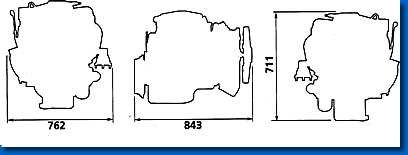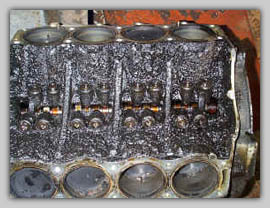 |
links to other FAQ pages
|
|
| FAQsGeneral V8 Engine Problems
FAQs |
Dimensions of the Rover V8 engine fully dressed, and weighing
in a 230KG all up.
|
With the Rover V8, it is never, 'how many miles they
have done',
but how they did them, this is a typical low miles
engine, It is not uncommen to see such contamination on a ten year or older
engine, that has covered typically less than 50K miles, & has had only
factory specified interval oil changes, but please dont let this put you off,
on the other side, a V8 that does a thousand miles a week would last
perhaps 200K miles and still be in great shape.
|
|
 How can I tell the condition of my
engine. by looking inside?. How can I tell the condition of my
engine. by looking inside?. |
 A good look inside the rocker covers through the oil hole will help me
determine the internal condition (and the minimum parts you will need for a
successful job.
A good look inside the rocker covers through the oil hole will help me
determine the internal condition (and the minimum parts you will need for a
successful job.
if your are unsure. it will be in one of the following
categories.
 Silver Alloy surfaces.?. Sounds Like a new
engine Silver Alloy surfaces.?. Sounds Like a new
engine
 Brown tarnished.?.Very low
mileage Dark brown.? perhaps higher mileage but well cared for. Brown tarnished.?.Very low
mileage Dark brown.? perhaps higher mileage but well cared for.
 Black ?.Getting poor, a full
rebuild/replacement should be considered. Black ?.Getting poor, a full
rebuild/replacement should be considered.
 Black
Coated & becoming dense ,? Very poor
condition, A rebuild is normally required Black
Coated & becoming dense ,? Very poor
condition, A rebuild is normally required
 Black and a "very" sludgy ?
Dead on its feet. Black and a "very" sludgy ?
Dead on its feet.
You can be sure this
method is a reliable way to determine, What you have, and What you should do.
"See the picture above, there is a lot about like this one, and worse. !!!.
|
|
 How can I tell if my Camshaft and
Tappets worn? How can I tell if my Camshaft and
Tappets worn? |
 It is easy to tell if a cam is worn out, without removing the engine or the
need for close inspection.
It is easy to tell if a cam is worn out, without removing the engine or the
need for close inspection.
When the tappets become worn, (Normally
60000 -80000 miles) The Tappet base becomes concave (dished) so when the
camshaft rotates, through 360 deg. , the tappet will only ride on the edge's of
the camshaft, and only making contact in the center when it goes over the (worn
to shape) cam lobe. this has the effect of causing the camshaft to be brown in
appearance and shiny on the edges. The cam in a Rover V8 is Hydraulic in its
design, this means when it is manufactured the lobe is cut at a slight angle so
that it rotates the tappets (essential for them to fill with oil) so even when
lobes still look to be intact, if the cam is starting to discolor it is well on
the way out, it is important to change the cam, before it start to wear away
quickly because the metal particles produced will quickly cause further wear in
the crank becoming embedded in the white metal bearings and softer aluminum
rockers, causing further engine wear and further metal particle's. Replacing
the camshaft and tappets before they get bad will greatly extend engine
performance and long life as well.
| Longer engine Life, Increased engine efficiency, smooth idle
and good power, are all "Not" to be expected from cams that look like this (and
it is not an uncommon sight) , |
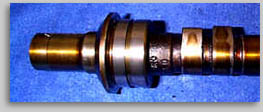 |
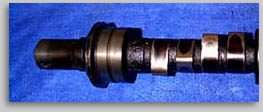 |
| Although you can see this cam is showing all the
discoloration's as mentioned, The Camshaft lobe's showing are all becoming
"rounded on the shoulders", its been bad for quite some time and would
have caused considerable harm to the engine already, not to mention the engines
performance and efficiency |
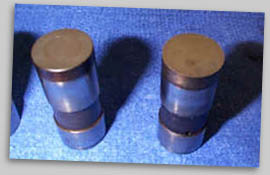 |
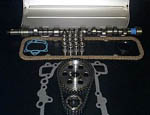
A range of Camshaft Kits
are available on our Special offer pages. |
Its
is clear to see the tappet on the left is already showing signs or becoming
worn, the center is dished (concave) the trouble is, the cam and tappets will
get a lot worse than this before you can actually hear them, and the gradual,
long term wear means you will not notice the power and economy losses either.,
So check the condition of your engine by the method we describe above, and
judge for yourself, if it's worth closer inspection.
|
If you are rebuilding any V8
engine It is becoming more and more essential to check tappet re-load as there
have been so many variants of the Rover engine components, and the engine
itself now spans over 30 years, so you can't normally "assume" anything, So if
you want to be sure of how your engine will end up. don't forget this important
issue. Tappet pre-load is the distance between the pushrod seat in the lifter
and the circlip, when the lifter is on the heel of the cam and the valve is
closed. Not setting the lifter pre-load, will cause premature wear, noisy valve
gear, and possible engine failure.!!. Or if your lucky "initial complete loss
of compression as the valve will not be able to close fully,
The
following information assumes that the following components are in good
condition - rockers, pushrods, valve guides and valve stems. a clearance of
.040" to a maximum of 0.60" must exist between the spring loaded pushrod seat
in the top of the lifter, and the underside of the retaining circlip. This
check should be made with the valve gear fully assembled, and the lifter empty
of oil, positioned on the lowest point, on the back of the camshaft. The
simplest way to measure the gap is by using round wire. Use a piece .040" for
the low clearance check, and a piece of .060" for the high clearance check.
Check all 16 lifters individually.
There are various ways to adjust the
pre-load on the Rover V8. normally a decrease off pre load is required and this
is achieved by using the "rocker pedestal shim kit" if the opposite applies the
it would be achieved by machining the rocker pedestals however in race and
higher end applications adjustable pushrods would be used.
 Shim Kits, are
inexpensive and include all the sizes you are likely to nee. Shim Kits, are
inexpensive and include all the sizes you are likely to nee.
 Adjustable
pushrods, are 3/8" and will require the guide holes to be elongated or
opened out. Adjustable rockers can be used and are available in a pack. It
would be wise to check your valve tip heights are all reasonably the same by
putting a straight edge across them. Also, we have seen cases where the rocker
pedestal mounting points cast into the head, are not parallel to the cylinder
head face. This can make it a long tedious operation. Remember to take into
account the rocker arm ratio of approximately 1.6. Make sure the shims are
properly aligned under the pedestal so as not to block off the oil supply. Do
not use shims of different thickness on the same shaft assembly, as breakage
may occur. Adjustable
pushrods, are 3/8" and will require the guide holes to be elongated or
opened out. Adjustable rockers can be used and are available in a pack. It
would be wise to check your valve tip heights are all reasonably the same by
putting a straight edge across them. Also, we have seen cases where the rocker
pedestal mounting points cast into the head, are not parallel to the cylinder
head face. This can make it a long tedious operation. Remember to take into
account the rocker arm ratio of approximately 1.6. Make sure the shims are
properly aligned under the pedestal so as not to block off the oil supply. Do
not use shims of different thickness on the same shaft assembly, as breakage
may occur.
|
|
 Beware fitting new tappets
only Beware fitting new tappets
only |
|
|
 |
After only 30000 miles or so this TVR developed some familiar
TVR rattly top end sounds.
A visit to the a (So called) reputable TVR
Garage fixed the problem by fitting some new tappets, believing that they may
have perhaps failed. and this was the appropriate cure
Tappets do not
fail and replacing them without changing the cam, does not work, You will see
why below. |
|
|
| We will not print any names, but it was suggested that it is
correct & proper to replace tappets only, even on an engine that has only
done 30,000 miles, Well with comments like that its no wonder why we can do so
much better for our customers. |
|
These three
tappets have only done 5000 miles on the engine they had been fitted to. They
all tell a story. from left to right its not looking good
|
Top. Comparing Cams, At 35000 miles and no sign of wear,
The Morgan cam is still looking good
Below. This Cam did not take to
its new tappets. So it was bad then and worse now.
|
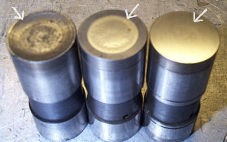 |
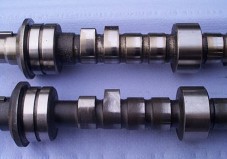 |
The left hand Tappet shows it is completely worn
out and after only 5000 miles it was the worst one on the engine. As expected,
it corresponded to the Camshaft lobe that was most worn (probably the one that
was the cause of the tappet noise in the first instance)
The middle
Tappet is also quite dished and this was going to be the next one to become
a major issue soon.
The left hand Tappet shows the signs of wear
(rounded indentation expanding from the center all other tappets on this engine
at only 5000 miles where showing bad signs of wear and the 3 depicted above
represent the extremes and average condition of what we found and what you
could expect
By possible luck, at the same time as working on this engine
we started work on a Morgan +8 which was going through a stage 3 upgrade, its
engine had done only 35000 miles and all the tappets where still in perfect
order, indeed in better shape (all 16) than the best of the tappets depicted
above.
 The later type
"Serpentine" V8 engines have the Camshaft further retained by a fixing
plate, (secured with two bolts). The later type
"Serpentine" V8 engines have the Camshaft further retained by a fixing
plate, (secured with two bolts).
The issue is that there are still a few
upgrade Cams on the market that do not have the added machining to re-use the
fixing plate.
Our's included !! (but were working on it.) This
however is not actually required, as nothing else has changed with the V8
engine and its 35 year old design to make this retaining plate necessary,
indeed the rotating chain would hold the cam true as would the thrust casting
that is still present on and all later type timing covers.
Assuming you have packed
the pump with Vaseline or grease, you have a strong charged battery and better
still the plugs are removed.
Maybe.
 The distributor drive
gear pin has come out, or the drive is spinning on the camshaft The distributor drive
gear pin has come out, or the drive is spinning on the camshaft
 The pressure Oil relief
valve is stuck open in the pump body. The pressure Oil relief
valve is stuck open in the pump body.
 The pump drive gears are
not broken The pump drive gears are
not broken
 The
strainer pipe is not fully tightened due to incorrect bolt. or the gasket is
split. The
strainer pipe is not fully tightened due to incorrect bolt. or the gasket is
split.
 The stainer
has a crack or fracture above the oil level line. or perhaps its
blocked. The stainer
has a crack or fracture above the oil level line. or perhaps its
blocked.
|
|
 Engine overheating
problems?
Engine overheating
problems? |
 Normally overheating would be caused by one of the following examples,
This however can only be true if there are absolutely no Internal signs of
gasket failure, Block cracked (mainly older 3.9's & 4.2's and this fault
cannot be seen (see below)) Or external water leaks, We would always recommend
head & Block pressure testing, or at least a chemical block
Normally overheating would be caused by one of the following examples,
This however can only be true if there are absolutely no Internal signs of
gasket failure, Block cracked (mainly older 3.9's & 4.2's and this fault
cannot be seen (see below)) Or external water leaks, We would always recommend
head & Block pressure testing, or at least a chemical block
1.
Not all temperature gauges are reliable, Try attaching an external gauge
to check readings are correct. also make sure you are using adequate Engine
cooling fans, We recommend Pacet cooling Fans systems
2. Check
the condition of the radiator (if not new) some have been filled with
sealer in there life and circulation can be a problem also if the fragile
cooling fins are corroded or missing the radiator will struggle to keep the
engine cool. also many altered vehicles may have restricted air flow to the
radiator, this may sound trivial but is worth considering.
3.
The most common problem is caused by Air locks, You need to be sure to
remove all air in the system. One of the most common traps is in the heater
radiator inside the car; this can be cleared sometimes by flushing it. To do
this remove the two pipes that pass through the bulkhead, Get a high pressure
garden hose if you use a commercial high pressure washer, you must not force
all the pressure through the radiator so hold the spay a few cm. away. What
happens is that for many years the water has passed through this radiator,
always in the same direction this means that deposits build up inside flushing
in both directions will normally reduce the amount of blockage.
4.
And most important, if you cant cure or find it don't drive it,
overheated engines will cause the oil pressure relief valve to stick open and
cause un-reversible and uncompromising damage
|
|
 Engine Overheating Problems 3.9
and 4.2 only (pre 96)? & 4.0, 4.6 post 96? Engine Overheating Problems 3.9
and 4.2 only (pre 96)? & 4.0, 4.6 post 96? |
 Over heating, Starts with water loss. The early 3.9 and
4.2 (pre 95-96) engines where, basically an over-bored 3.5 casting with 4mm
extra on the diameter of the liners, this caused a reduced thickness of
aluminium between the water jacket and the cylinder bore. The subsequent water
loss problem normally starts off as just a water light that appears once a
month or so, Then once a week until it becomes a permanent feature, The normal
unsuspecting owner, will have by this time paid for heads to be skimmed and
gaskets to be changed by which time they have spent a lot of money already. So,
although the engine functions fine it is a permanent worry leading towards a
Total engine failure. Over heating, Starts with water loss. The early 3.9 and
4.2 (pre 95-96) engines where, basically an over-bored 3.5 casting with 4mm
extra on the diameter of the liners, this caused a reduced thickness of
aluminium between the water jacket and the cylinder bore. The subsequent water
loss problem normally starts off as just a water light that appears once a
month or so, Then once a week until it becomes a permanent feature, The normal
unsuspecting owner, will have by this time paid for heads to be skimmed and
gaskets to be changed by which time they have spent a lot of money already. So,
although the engine functions fine it is a permanent worry leading towards a
Total engine failure.
Many would be excused for thinking that the
overheating is caused by running the engine in a Hot climate, or with a
radiator problem. or even insufficient cooling fans, or Oil cooler but we can
assure you, this is not normally the case.
3.9
& 4.2 The true & main reason these engines run very hot is
due to the fuel/air ratio, or fuel mixture, that is controlled by the engine
EFi computer, (ECU Chip) from the factory this was designed to run very lean
through the mid range, to make altitude driving or mid range emissions (tested
in some countries) less of a problem, the upshot of this however is when these
engines are used on low quality or low octane fuels or when indeed the engines
are upgraded with items even as minor as free flow air filter, or exhaust
headers, & Cam/Head upgrades, although all of these are only mild upgrades
they will make weak engine run even weaker, and the problem will get
closer!!
The solution is simple. (If its not cracked already) fitting our
Optimax or Tornado Eprom (ECU Chip) will give your engine the near perfect fuel
/ air ratio, it deserves thus, lower engine internal temperatures and give,
without other modifications to all 15% efficiency [power and economy & also
allow the upgrades you have already done, to be beneficial at last, instead, of
being detrimental. 3.9 & 4.2 ECU info
"Click"
4.0 & 4.6 (New shape)Suffer a similar but
normally less dramatic problem, although these engines are much stronger, "The
Same" Air/ fuel ratio problem will arise with low octane fuels, you will not
normally however suffer cracked blocks, but you will cause the Liner to shift
from its seat or cause sticky valve guides (partial seizure) and the solution
is much the same as the 3.9 & 4.2 above, an ECU re chip will sort it out
and more Gems ECU info "Click"
All
cracked engines (blocks) are not normally repairable due to the fact that it
will crack behind other liners, even if you could effectively repair the one at
fault
If you are undecided about where the problem actually is,
then the next job would be to remove the heads if you see nothing then suspect
the worst. (The surest way to tell if your engine is suffering from this
problem is the fact that you can find nothing obvious wrong) you could have the
heads & block pressure tested if you are still not convinced).
Its no
coincidence that the Piston on the right. ( No's 7) seems to have been
'steam. cleaned'
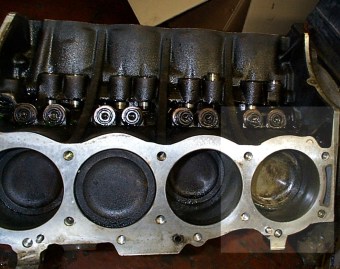 |
|
This is a sure sign of the cylinder
block being cracked somewhere behind it, In many cases such as this one you
will also find that the cylinder liner has moved down the bore slightly . The
problem with this engine had been wrongly diagnosed by the main agent ( at a
cost of £600.00) to a 4 though, warp in the centre of the head.
Want to see more.
Which is, clearly incorrect. But please
be sure, This is not a problem caused by the 4.6 engine itself, or indeed any
of the smaller V8's , but is caused by the very weak fuel maps they are
subjected too With modern, (un-chipped) Std... fuel injection ECU.'s and the
resultant very high cylinder temperatures they run!!.
|
|
|
 Why should I be careful buying a "used
3.9 or 4.2"? Why should I be careful buying a "used
3.9 or 4.2"? |
 Buying Used 3.9, 4.0, 4.2 or 4.6 engines. Please be very very sure if
you purchase this 'used engine' You get a written warranty From a reputable
supplier, However also realize that although they might refund your money, they
cannot replace your wasted time and fitting expenses. (one reason why RPi. will
not sell used engines)
Buying Used 3.9, 4.0, 4.2 or 4.6 engines. Please be very very sure if
you purchase this 'used engine' You get a written warranty From a reputable
supplier, However also realize that although they might refund your money, they
cannot replace your wasted time and fitting expenses. (one reason why RPi. will
not sell used engines)
You can find more (And some the same) on our
V8 general information page
|
 Adjusting end float, mains bearings.. Adjusting end float, mains bearings.. |
All oversize
bearings have oversized thrusts, therefore the crank end float must be adjusted
on no 3 ( center) end cap. To do this - take 2 pieces of 1000/1200 emery paper
and a flat surface ie glass. Rub down thrusts equally on both sides until a
clearance of 6-14 thou is achieved.
|
 Setting up and checking for problems. Setting up and checking for problems. |
 First
remove advance vacuum pipe from intake and check for positive vacuum when
throttle is applied. First
remove advance vacuum pipe from intake and check for positive vacuum when
throttle is applied.
 Check if (fitted) that the vacuum delay module is not
blocked. Check if (fitted) that the vacuum delay module is not
blocked.
 Check
positive vacuum will pull distributor advance whilst also checking vacuum
module is not holed. (when sucking the pipe, the base plate of the distributor
should rotate anti-clockwise about 15 deg.) Check
positive vacuum will pull distributor advance whilst also checking vacuum
module is not holed. (when sucking the pipe, the base plate of the distributor
should rotate anti-clockwise about 15 deg.)
 Check condition of rotor arm for signs of damage or
arcing, also check cap and clean contacts (better still fit new) Check condition of rotor arm for signs of damage or
arcing, also check cap and clean contacts (better still fit new)
 Check rotor for free play, there should be none, both
rotationally and side to side. Check rotor for free play, there should be none, both
rotationally and side to side.
 Check rotor will turn clockwise through about 20 deg.
and smartly retract back to it's home position under good spring tension. Check rotor will turn clockwise through about 20 deg.
and smartly retract back to it's home position under good spring tension.
 Distributor output is known to be weak so upgrading with
our Spark amp is recommended. (see below) Distributor output is known to be weak so upgrading with
our Spark amp is recommended. (see below)
 Replace plug leads, preferably with Magnecor. Use good
quality Plugs such as NGK BP6ES, avoid fancy plugs, as they don't normally last
long. Replace plug leads, preferably with Magnecor. Use good
quality Plugs such as NGK BP6ES, avoid fancy plugs, as they don't normally last
long.
A check list of common simple issues
 .Being sure of TDC' appropriation, with regard to crank
indicated timing mark is a must. .Being sure of TDC' appropriation, with regard to crank
indicated timing mark is a must.
 Plug gap needs to be 0.8mm - 0.9mm. Plug gap needs to be 0.8mm - 0.9mm.
 Don't use resistor plugs and suppressed leads together. Don't use resistor plugs and suppressed leads together.
 Std. spec. high street leads may not be able to handle
the extra spark KV's'. Std. spec. high street leads may not be able to handle
the extra spark KV's'.
 Check fuel delivery pressure. Check fuel delivery pressure.
 Check Carb. float bowl height. Check Carb. float bowl height.
 Check no blocked or restrictive fuel filter in line. Check no blocked or restrictive fuel filter in line.
 Do you have the fuel return hose (to the tank) connected
?.if so it needs restricting. Do you have the fuel return hose (to the tank) connected
?.if so it needs restricting.
 Try an alternative coil even if your is new?.. Try an alternative coil even if your is new?..
|
|
. For other Injection related
problems & chipping issues , see relative injection pages.
Never under-estimate the quality of Std, O/E, or High street spec. ignition
leads.
A typical e-mail "quote"Thank you for helping me
sort out my misfire problem with the amplifier. You may recall when we spoke
that I said that the misfire was when on LPG when the engine was cold. You
recommended fitting Magnacore leads as well, but as I had new Lucas leads
fitted I said that I would try them out with the amplifier first. The result is
the engine is sweet as a nut when cold and a definite improvement in power and
fuel consumption.
I am very pleased with it and will be recommending
other gas users I speak to. Yours sincerely Peter Munday
Below are the graphs for 5.0
and 5.3 litre V8 engines that we have recently had dynode. More info
soon
Click the graphs for a more detailed (higher res) version
|
5.0 litre
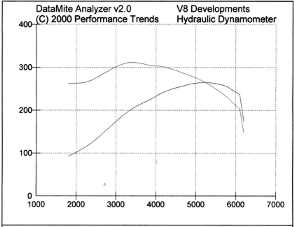 |
5.3 litre
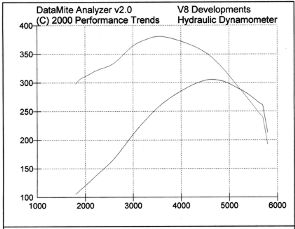 |
|
|
|
|
|
This FAQ Q/A Section
is solely for information exchange only, and RPi. or its contributors accept no
lability for any issues arising from following up on our printed advise, or
subsequent cost that may arise from the same,
For our part we do
our best to check all information provided and printed is correct to the best
of our knowledge. And as V8. specialists for 15 years we don't get it wrong
often.
|











